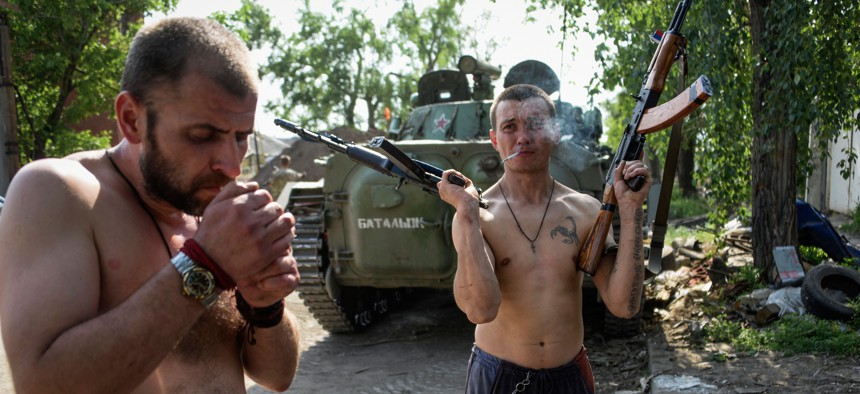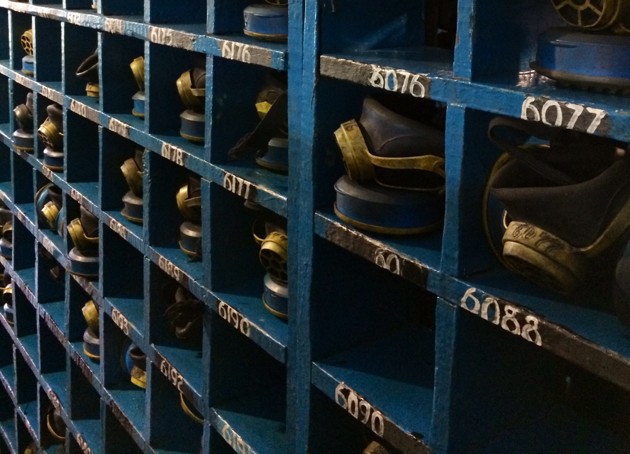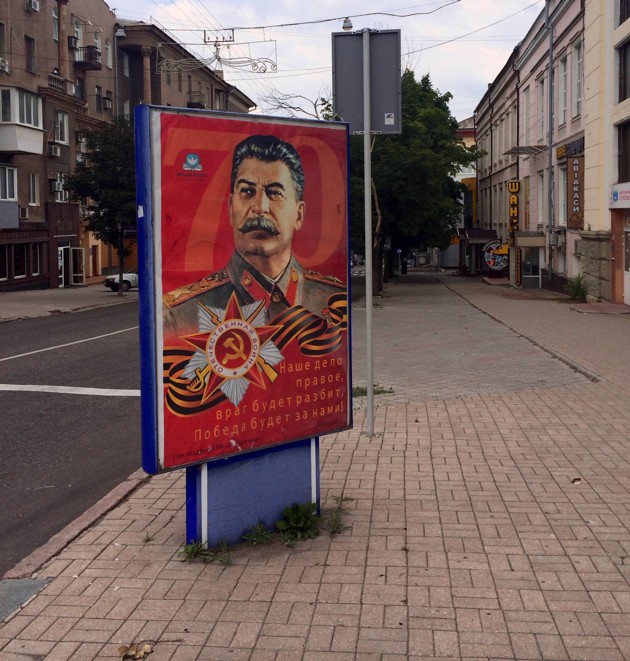
A Russia-backed rebel smokes, holding rifles in his both hands, on the outskirts of Donetsk, eastern Ukraine, Tuesday, May 26, 2015. Mstyslav Chernov/AP
How to Make a Country Vanish: A Journey Inside Eastern Ukraine
From mailboxes to license plates, Russia is everywhere in eastern Donetsk.
DONETSK, Ukraine—Deep in the self-declared Donetsk People’s Republic (DPR) on Ukraine’s eastern fringe, crumbling statues of Lenin were guarding a century-old coal mine, testifying to a former master who had begun encroaching again. A high-pitched bell sounded, signaling the end of the night shift, and a precarious cage brought exhausted, soot-faced workers to the surface. The sudden glare of daylight made the miners squint. “These men are finally working honestly,” the mine’s chief engineer, Andrei Popovchenko, told me. “Under Ukraine, things were corrupt and illegal. Taxes were stolen.” We were walking around the Udarnik mine in Snizhne, which lies east of the city of Donetsk, close to the Russian border.
More than a year into the war between forces loyal to the Ukrainian government in Kiev and pro-Russia rebels in eastern Ukraine, the formerly 460-strong staff at Udarnik had dwindled by around half. (The mine’s name means “shock worker,” a prestigious Stalin-era title for an employee whose production exceeded quotas.) Many of the miners had fled the violence; 12 had gone to fight on the side of the rebels, Popovchenko said. “We’re holding places for them, just as we would for a woman on maternity leave,” he told me with a wry laugh. Udarnik’s modest monthly production of 3,700 tons of coal would be sold “internally” within the DPR. “Why sell to Ukraine when we need to help our own people?” he asked. Much to the chagrin of officials in Kiev, Ukraine still receives the bulk of its coal—a resource necessary for about 40 percent of the country’s electricity production—from the rebel-controlled east.

Respiratory-protection masks at the Udarnik coal mine in Snizhne (Amie Ferris-Rotman / The Atlantic)
This division between what natives of the Donetsk region now call “Ukraine” and their own statelet of the DPR, carved out by separatists last May and recognized by no one else, appears to be solidifying. Separatist-held areas—which before the war were home to around 4.5 million people—are still hurting from the Ukrainian government’s move last November to halt payments for pensions and public services in the region. The gulf appeared to widen further last week, when Ukraine’s parliament took a step toward changing the constitution to devolve more powers from the central government to the country’s eastern regions, as part of a ceasefire agreement signed in February in Minsk. But in eastern Ukraine itself, the move to decentralize power seemed almost irrelevant.
Reaching the Donetsk region from Kiev involved a long train journey followed by hours of driving through five heavily armed checkpoints to cross the frontline-cum-de facto border between Ukraine and the DPR. In what seemed like a tacit recognition of this border, Ukrainian border guards stamped foreigners out of Ukrainian-held territory, leaving a purple ink square in their passports. Colonel Andriy Lysenko, a Ukrainian military spokesman, said this was a “temporary measure aimed at safety and security.”
Though there were rebel police on the streets of Donetsk, it was not entirely clear what laws applied, and people were on edge. A region-wide curfew of 11 p.m. was in place. Despite the February ceasefire signed by the leaders of Russia, Ukraine, France, and Germany—the second ceasefire of the conflict, since the first began falling apart shortly after it was signed last September—fighting continues in a war that has claimed the lives of more than 7,000 civilians and 1,675 Ukrainian soldiers over the past 16 months. It is unclear how many rebels have been killed.
Across the Donetsk People’s Republic, traces of Ukraine were successfully being extinguished. Most Ukrainian businesses along the capital city’s birch-lined boulevards were fading into oblivion—shops shuttered, ATM screens and cell-phone top-up booths covered in a thick film of dust, untouched for months. Many foreign firms had also pulled out of the region due to security concerns. On the city’s yellow mailboxes, the Ukrainian word for “post”— poshta —had been changed to Russian— pochta —in crudely drawn marker, a divisive difference of one letter. Ukrainian license plates were gradually being replaced with ones belonging to the DPR. The Russian ruble, with its tributes to Czar Peter the Great and Moscow’s Bolshoi Theatre, was omnipresent, fast replacing the Ukrainian hryvnia and its depiction of Kiev’s Saint Sophia Cathedral. In a sprawling, covered outdoor market, rubles and hryvnia were quickly interchanged, as traders made fast mental calculations. “I actually prefer the ruble,” said Natalia, a jovial 47-year-old who was selling shoelaces and hair accessories. “Hopefully we’ll soon move completely to the ruble, as we’re not going back to being part of Ukraine.”
Alexander Khodakovsky, a senior rebel commander now serving as the DPR’s security minister, estimated that the ruble is now used in 80 percent of transactions across the region. “We have no illusions about Russia; we know it has many problems, but Russia is also our country,” Khodakovsky told me in his vast office, the walls of which were adorned with oil paintings of Russian Orthodox saints. On his wide desk sat a statuette of Felix Dzerzhinsky, the founder of the notorious Soviet secret police that would become the KGB. Atop the 11-story self-proclaimed government headquarters near his office flapped the black, blue, and red flag of the DPR; beside it flew the Russian flag. Graffiti saying “Russia” was scrawled across the building’s cement side. The Russian government has consistently denied military involvement in Ukraine, saying instead that its soldiers in rebel-held territory are merely “volunteers.”
Russia was everywhere, Ukraine was nowhere, and Donetsk’s clumsy patron manifested itself in ways both mundane and bizarre. Inside one of the city’s biggest supermarkets, fragments of the store’s previous existence were still visible. Once a branch of ATB, Ukraine’s largest retailer, it was now called simply “grocery store” ( gastronom , in Russian), though ATB logos remained on the shopping carts. The majority of the food for sale was Russian. Of the 37 types of butter on offer, two were Ukrainian. Security fears and sometimes days-long waits at checkpoints mean many Ukrainian goods do not reach the rebel-held east—also including the region of Luhansk, which, together with Donetsk, forms what separatists call Novorossiya—and locals complain of a punitive blockade . Gas stations belonging to Ukrainian firms such as Parallel were boarded up, though others, which had been Shell and BP, were functioning, albeit with the unmysterious name ROS-OIL, the slogan displayed in black letters against a circular Russian flag. “What we’re seeing is the nationalization, or quasi-nationalization, of local brands, replacing international business that will no longer operate due to [lack of] security,” Taras Kachka, who heads the nongovernmental organization Ukraine Reforms Communications Taskforce, told me in Kiev, adding that this process was being carried out under the auspices of the DPR, but not without Russian aid.
Instead of Coca-Cola there was “Real Cola,” almost identical in packaging and taste to the American original, but with a Novorossiya flag on its side and made in Russia. Comical Soviet nostalgia was on display: Large framed posters of Stalin dotted the city center in a display organized by the “ White Book ”charity, which was set up to “assist victims of criminal activity relating to the Kiev regime,” according to its website. An online film project from the separatists’ Ministry of Culture, called the “ Arrow of Fate ,” told the story of a DPR tank-driving rebel who managed to seduce a blonde woman garbed in the full skirt and button-down blouse associated with the 1950s, in a tale reminiscent of the deluge of popular post-World War II films produced by the Soviet Union’s propaganda machine.

A poster of Stalin in central Donetsk (Amie Ferris-Rotman / The Atlantic)
Russians were even helping the people of Donetsk identify their dead. In the city’s crowded and pungent morgue, where semi-naked, waxy bodies lay scattered in unrefrigerated rooms, the director, Dmitri Kalashnikov, told me of future plans to build a DNA-testing lab nearby. The morgue, he said, currently has to send unidentified bodies to Dnepropetrovsk, home to the closest DNA-testing lab, across the frontline in Ukrainian territory. “It’ll be much easier and quicker to identify the bodies right here,” Kalashnikov said resignedly, adding that the “Russian experts” behind the DNA lab would arrive by autumn. Kalashnikov, who ran the morgue before war erupted, was clearly exhausted, his face marked with sorrow. He had seen hundreds of nameless bodies come through the morgue. Ukrainian President Petro Poroshenko has estimated that 1,000 civilians are missing in the east, but Kalashnikov said he thinks the figure “is far, far higher.” When we stepped into the morgue’s dappled courtyard, two white trucks parked nearby hummed as they cooled the bodies inside.
Among the only Ukrainian products still reaching Donetsk were free packages of food staples, destined for the hundreds of thousands of pensioners, invalids, and young families who lost support when the Ukrainian government began closing down banks and services in the region.
On a recent blistering morning, a procession of parents wound their way into the local soccer stadium for handouts of baby food. With its 52,000 seats permanently empty, the sleek Donbass Arena—which hosted the Euro 2012 semi-final—stood testament to the biggest war in Europe since the Balkan conflict of the 1990s. Orange block lettering marked what had been the stadium’s “Fan Shop.” Between its bare walls, volunteers were busy unloading bags of fruit puree, dried milk, pasta, oil, flour, and sugar. “I doubt the food situation will improve any time soon,” said 29-year-old Nadezhda, a black-haired housewife, as she collected a package for her small daughter. The food came from the Rinat Akhmetov Foundation ’s charity arm, set up by its eponymous founder and Ukraine’s richest man. Ironically, it was that Donetsk native who built the $425-million stadium six years ago. A volunteer named Olga Tseselskaya estimated that the Foundation was feeding around half a million people in the Donetsk and Luhansk regions. “More than anyone else, this war is affecting peaceful citizens. With the border [with Ukraine] tightening, we have no choice but to help,” Tseselskaya told me.
Behind the city’s grand and gray theater sat the Donetsk arm of the Lviv Handmade Chocolate Café, a quiet nest of resistance. It’s part of a chain of stores across the country that originated in the western city of Lviv; by company rules, the staff must wait on customers in the Ukrainian language, which came as something of a shock in a city where gun-wielding rebels bent on fighting Kiev roamed the streets. “Many people in the town are surprised we’re still functioning, but we’re happy to work here,” a senior member of the management told me, speaking on condition of anonymity. Supplies came from the chocolate factory in Lviv, and were sometimes delayed for weeks, she said. Display shelves by the entrance, usually filled with an array of freshly made truffles, were conspicuously empty. But high heels and teddy bears cast in milk chocolate were boxed up and ready for sale.
Something else was awry. The café’s Kiev branches have a product that was missing in Donetsk: chocolate figurines of Vladimir Putin, clad in military fatigues with his arm wrapped behind his back. In his hidden palm, he holds an edible grenade.



